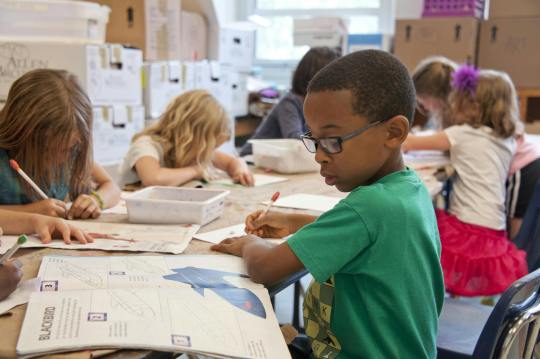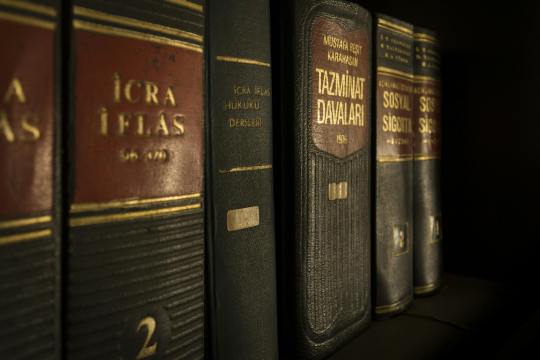Active with the Greenburgh School District in New York State, Bob Chakar is the GED coordinator and literacy specialist. He works to implement language arts and reading programs that meet the needs of vulnerable students throughout Westchester County. Bob Chakar’s current position builds on a longstanding role as Andes Central School District principal and superintendent. Known as an accessible and approachable leader in the school district, Mr. Chakar worked closely with the teachers’ union and multifaceted administrative teams. He informed the process of recruiting well-qualified staff members. Identifying instructional needs, he brought in personnel to fill highly specific roles. He also established a rigorous, standards-aligned curriculum that benefitted students socially and academically. Bob Chakar holds a doctorate in educational leadership from the University of Bridgeport. He wrote his dissertation on topics close to his heart, including the educational impacts of segregation and resegregation in the United States and the decision in the landmark Brown v. Topeka case.
Don't wanna be here? Send us removal request.
Text
Importance of Integration in the School System

While many landmark rulings, including Brown v. Board of Education (1954), have helped end segregation in American schools, integration remains a major unresolved issue. An April 2025 article by the Century Foundation focused on the importance of integrated public schools in helping to ensure equitable outcomes. Through integration, students of various races and backgrounds work together toward common goals, and polarization, division, and an “us-versus-them” mentality diminishes.
The author focuses on the student-led IntegrateNYC’s “5Rs of Real Integration” model as a starting point for discussion. The first element of this centers on enrollment representing the various ethnic and racial identities within communities, as well as “intersectional forms of identity” such as gender, sexual identity, ability status, and primary language. Integration must extend beyond the classroom to include everything from cafeteria seating to after-school programming.
A second plank is “restorative and transformative justice,’ which originated in the criminal justice space. The restorative aspect centers on healing work that encourages individuals to acknowledge and prevent harm. The transformative aspect involves changing the system if it perpetuates harm and injustice. “Positive, inclusive relationships” is a third plank, with this element focusing on fostering a sense of belonging and trust among teachers, students, staff, and families within the broader community.
The fourth element is “representation,” which focuses on ensuring that teachers, PTA leaders, and staff reflect the students they serve in terms of ethnic diversity and intersectional identities. School curricula have built-in diversity that school leaders help select and implement, as well as incorporate student and staff voices within decision-making processes. The fifth and final 5Rs element is “equitable resource distribution,” or ensuring that educational funding flows, without favor, to programs that represent diverse districts and constituencies.
Next, the author adds a sixth plank of “civic engagement opportunities,” by which she means providing students the chance to engage in democratic decision-making. As she puts it, “inclusive, just, and diverse classroom spaces are pivotal for a pluralistic democracy.”
According to National Assessment of Educational Progress (NAEP) findings, students in integrated schools have substantially higher average test scores than those attending schools with concentrated poverty, As an example, in 2011, 4th-grade low-income students who attended more affluent schools scored two years of learning ahead of students in the same income bracket who attended high-poverty schools.
Integrated schools reduce stereotypes and racial bias, which may increase in racially isolated settings. One study found that students attending racially diverse high schools are more likely to reside in diverse neighborhoods five years after graduation.
While creating diverse and equitable educational environments may seem like an uphill battle, numerous examples of successful programs exist. For example, the New York State Integration Project, launched in 2015, sought to address chronic school underperformance and school segregation. The program channeled school-improvement funding from the federal government toward turnarounds of struggling schools. It created dynamic magnet programs that promoted diversity and attracted students learning English and with disabilities.
A significant percentage of the funding also provided training, education, and support to district leaders, resulting in a self-sustaining professional learning community that fostered best practices and policies. Grants toward this project were initially noncompetitive but, when successful, led to competitive bids for greater amounts of funding toward magnet program implementation.
0 notes
Text
0 notes
Text
0 notes
Text
0 notes
Text
0 notes
Text
Evolution in Education After Law Outlaws Segregated Schools

In January 2016, the Topeka Public School’s Board of Education appointed Tiffany Anderson, PhD, as its superintendent, becoming the first African American woman to lead the district. In a May 2024 interview with CBS Evening News, Dr. Anderson stated that she aims to build on the legacy of the landmark Supreme Court case Brown v. Kansas Board of Education (1954), which ended segregation across the American educational system.
Seventy years later, impacts from this ruling set precedence for other court decisions, created instances of resegregated schools, and established pathways for post-affirmative action graduates.
In 2024, nationwide celebrations commemorated the ruling that determined that separate but equal did not serve as a just way to educate the nation’s children. Organizations and individuals marked the event by hosting panel discussions and art exhibits to honor the legislation that sought to reduce educational disparities.
Brown v. Kansas Board of Education became a critical Supreme Court case in the American narrative because it removed the social barriers that kept minorities, namely African Americans, from accessing resources connected to the political and economic spaces that influenced life in the US.
At the time, other states also had cases waiting for Supreme Court ruling best the Brown, including Delaware, South Carolina, Virginia, Kansas, and the District of Columbia. When the Court combined the cases into the Brown v. Board of Education, roughly 200 plaintiffs sued the board of education in these states for the right to integrate. In Topeka, 13 parents sued the state board of education for 20 children.
Before Brown v Board of Education, the US educational system established segregated education to educate black and white students in 1896 with the Supreme Court ruling Plessy v Ferguson. The ruling stated that the law permitted segregated schools if the resources and institutions provided equally for both sets of students. Before Brown v. Board of Education, other municipalities unsuccessfully sought to end segregation in the public school system.
In Brown v Board of Education, the Topeka public school system had adequately ensured it adhered to the separate but equal mandate. However, the lawyers for the plaintiffs argued that this segregated system caused detriment to children. In 1954, the Supreme Court agreed that, even with separate but equal measures, black children became deprived of educational opportunities.
The ruling had immediate and long-term impacts on education and ending practices that marginalized this community. A year later, in 1955, Rosa Parks, Martin Luther King, and other civil rights activists led the way that removed Jim Crow laws, and that led to the Civil Rights Act (1965), Voting Rights Act (1965), and the Fair Housing Act (1968). The Brown v. Board of Education ruling also set precedence for removing segregation from private schools. Runyon v. McCrary (1976) stated denying a student admission based on race violated federal civil rights laws.
Some public school systems countrywide still experience the impacts of segregation within their districts, sometimes unintentionally. For instance, corporation-wide redistricting and segregation-influenced racial disparities have impacted educational inequities in elementary schools in Topeka. Figures reveal the marked difference in student performance between whites and minorities (Black).
According to a January 2024 article, only 12.2 percent of Black students had proficiency in math and English compared with 44 percent of White students. In the case of the new city of St. George, residents fought and petitioned the Louisiana Supreme Court to incorporate as a city, creating a predominantly white (70 percent) majority. Residents petitioned the court because they felt Baton Rouge schools had not adequately educated its students. By choice or legal mandate, schools nationwide have started resegregating.
It also touches on affirmative action practices. When instituted as a part of the Civil Rights Act legislation, affirmative sought to level the playing field by providing women and minorities access to educational and employment opportunities. However, after multiple cases over the years have challenged this part of the Civil Rights Act, the Supreme Court struck it down in 2023 regarding race-based decisions in universities nationwide.
Some places report that the decision has little impact on minorities' access to higher education, with schools such as Indiana University seeing increases in Asian, Hispanic, and Black students in its Fall 2024 class.
This ruling and challenges to teaching critical race theory are present obstacles to openly discussing race and racial inequities in the educational landscape. Ultimately, Brown v. Education provided not only access to minorities of all races but also built a foundation where race, racial inequality, and their impacts have a platform, one protected under civil rights legislation.
0 notes
Text
What Are Individualized Education Programs?

In special education, individualized education programs (IEPs) help ensure that students with disabilities receive support to thrive in school. As the number of students with disabilities continues to rise, reaching an all-time high of almost 15 percent of all students nationwide in the 2021-22 school year, understanding IEPs is important for both educators and parents.
An IEP is a legal document that outlines the special education instruction, support, and services a student needs to make progress and succeed in school. IEPs are tailored to meet the individual needs of students with disabilities. Covered by the Individuals with Disabilities Education Act (IDEA), IEPs are a fundamental part of the public education system, including charter schools.
To be eligible for an IEP, a student must have an IDEA-covered condition and require special education services to thrive in school. IDEA covers 13 conditions, including dyslexia, speech impairment, and autism spectrum disorder. Not every student with a disability qualifies for an IEP - the disability must significantly affect their school performance.
The IEP process begins with a comprehensive evaluation to identify the student's strengths and challenges. This assessment involves various professionals, including classroom teachers, psychologists, therapists, and special education teachers. After examining the results, the student's family collaborates with the school to create an IEP that meets the student's unique needs.
The IEP lists the student's current cognitive ability, language and social interaction development, and speech skills. Using this initial assessment, the family and the school design short-term and long-term goals. An example of a short-term goal is improving study skills. An example of a long-term goal is successfully being admitted to a college.
IEPs also cover inclusion by specifying how much time students will spend in general education settings. To ensure students can thrive in these environments, the document outlines necessary accommodations and modifications that must be made. The IEP includes a framework for tracking and communicating progress, allowing ongoing assessment and adjustment of the strategy. This approach ensures that the IEP is a dynamic guideline that supports the student's development.
Beyond the educational benefits, IEPs offer legal protections for students and their families, ensuring that students receive individualized support and services. IEPs also allow families to be actively involved in educational decisions, thereby providing the best learning experience. Moreover, IEPs aim to integrate special education students into general education settings as much as possible, with the ultimate goal of helping students follow the same curriculum as their peers without additional support.
Some may confuse IEPs and 504 plans. While both can provide accommodations and assistive technology, 504 plans are not part of special education. They are developed for students whose disabilities do not require specially designed instruction, but still need certain accommodations.
Implementing IEPs can be challenging, particularly because of the ongoing special education teacher shortage. Despite these challenges, schools are required by law to meet the individual needs of students with disabilities. To meet these legal requirements, schools make sure that all teachers are involved in a student's education, including general education teachers. Schools also recognize and implement the accommodations and services outlined in the IEP.
0 notes
Text
How to Help Children Develop Critical Thinking Skills

Critical thinking is a skill that every individual must possess. With critical thinking skills, an individual is able to make informed and rational decisions rather than act on impulse. Aside from helping one make the right decisions, critical thinking can help people be more emotionally intelligent, demonstrating empathy to other members of society. According to Oxford Languages, critical thinking is the process of objectively analyzing and evaluating issues to form an opinion or judgment. Because critical thinking is learned and not inborn, it is important that more educational institutions inculcate this skill in their curriculum. This means that children should be taught how to analyze and assess situations and form an independent and objective opinion on issues.
Children are naturally inquisitive. They are always eager to ask questions about concepts that they do not seem to understand. So, to help children develop critical thinking skills, both parents and teachers should encourage them to ask questions. Entertaining students’ questions makes them more inclined toward problem-solving. It also gives them a better perspective on issues and helps them form informed and well-thought-out opinions. It is important to allow children to first ponder their questions before giving them an answer. This gives them the opportunity to think, agree, or disagree with external opinions and form independent opinions.
Another way to help children hone their critical thinking skills is by allowing them to develop their own hypotheses. A hypothesis is a proposed explanation or a conclusion that is thought out based on available evidence. It is sometimes described as a scientific guess. One way to help children develop a hypothesis is to ask for their opinion on the likely outcomes of the plot of a novel or movie. Also, asking children open-ended questions on random issues prompts children to come up with creative answers.
Encourage them to love mathematics. Mathematics is key to critical thinking because it comprises a series of logical steps that help one to arrive at an expected result. For instance, mathematics encourages children to recognize patterns and also helps them to experiment by engaging in error and trial. Error and trial help children to better realize that they cannot always be right, so it is important not to be afraid to change their opinion when they spot an error. On the other hand, pattern recognition helps the child to make informed opinions based on past experiences.
According to C.S. Lewis, a notable British scholar, failure can serve as a signpost of “the road to achievement.” This means that teaching children that mistakes and failures are part of life will ease the pressure of making decisions. Helping them to understand that it is not possible for one to always make the right decision helps them to be more open-minded, entertain different opinions, and be more fluid in their thoughts.
Further, creating art can also be instrumental in helping children develop creative thinking skills. Art is a form of self-expression, so teaching children to channel their thoughts, opinions, and feelings into art helps them to be more self-expressive and emotionally intelligent because critical thinking involves the ability to channel emotional impulses more accurately and rationally. Writing poems, painting images, and composing music all play important roles in helping children gain mastery of words and self-expression.
Finally, to help children develop critical thinking skills, they should be given more opportunities to learn. Thoughts can only be built on existing knowledge, so creating an enabling environment where children can learn will help them to form better opinions.
0 notes
Text
The Historic Anniversary of Brown v Board of Education
As we are five months into the 70th anniversary of the initial Brown decision, I would be remiss to not identify in some detail the court cases that helped paved the way for desegregation. The U.S. Supreme Court decision in Brown was one of the most pivotal opinions ever rendered by that body. This landmark decision highlighted the court’s role in affecting changes in national and social policy. Often when people think of the case, they remember a little girl whose parents sued so that she could attend an all-white school in her neighborhood. In reality, the case of Brown was far more complex. The Brown case originated in December 1952, when the U.S. Supreme Court had on its docket four separate cases from South Carolina, the District of Columbia, Virginia, and Delaware, all of which challenged the constitutionality of racial segregation in public schools. The case of Briggs v. Elliott was from the Eastern District of South Carolina, Bolling v. Sharpe was on certiorari for the District of Columbia Circuit, Davis v. Prince Edward County was from the Eastern District of Virginia, and Gebhart v. Belton was on certiorari from the Supreme Court of Delaware.
The U.S. District Court consolidated these four cases with the Brown case under one name, Oliver Brown v. The Board of Education of Topeka. The justices believed that it was better to have representative cases from different parts of the country “so that the whole question of segregation would not smack of being a purely southern one.”380 Although the four other cases were combined with Brown, the cases were premised on different facts and different local conditions, but all contained a common legal question that justified their consideration together.
380 Brown v. Topeka, 347 U.S. 483 (1954).
For this post, I would like to draw attention to the South Carolina case. In the South Carolina case, Briggs v. Elliott, the plaintiffs were black elementary and high school children living in Clarendon County. 381
381 Briggs v. Elliott, 132 F. Supp. 776 (1955).
The parents brought action in the U.S. District Court for the Eastern District of South Carolina “to enjoin enforcement of provisions in the state constitution and statutory code,” which required the segregation of blacks and whites in public schools. The Briggs case was named for Harry Briggs, one of twenty parents who brought the suit against R.W. Elliot, the president of the school board of Clarendon County, South Carolina. Initially, the parents only asked the county to provide school buses for the black students as they did for whites. When their petitions were ignored, they filed a suit challenging segregation itself. A three-judge U.S. District Court convened under 28 U.S. C. @ 2281 and 2284 and denied the requested Relief. The plaintiff’s appealed to the U.S. Circuit Court of Appeals, and it found that the black schools were inferior to the white schools and ordered the defendant school district to begin immediately to equalize the facilities. The court of appeals, however, sustained the validity of the contested provisions and denied the plaintiffs admission to the white schools during the equalization program. The court of appeals vacated the lower district court’s judgment and remanded the case back to the district court for the purpose of obtaining the district court’s views on a report filed by the defendants concerning the progress made in the equalization program. On remand, the district court found that substantial equality had been achieved except for buildings and that the defendants were proceeding to rectify this inequality as well. Next post will be Bolling v. Sharpe, 344 U.S. 873 (1952).
1 note
·
View note